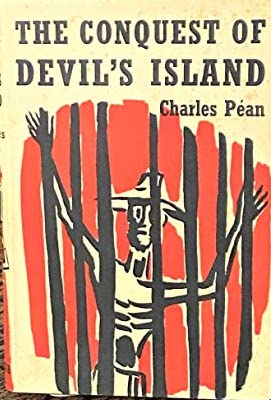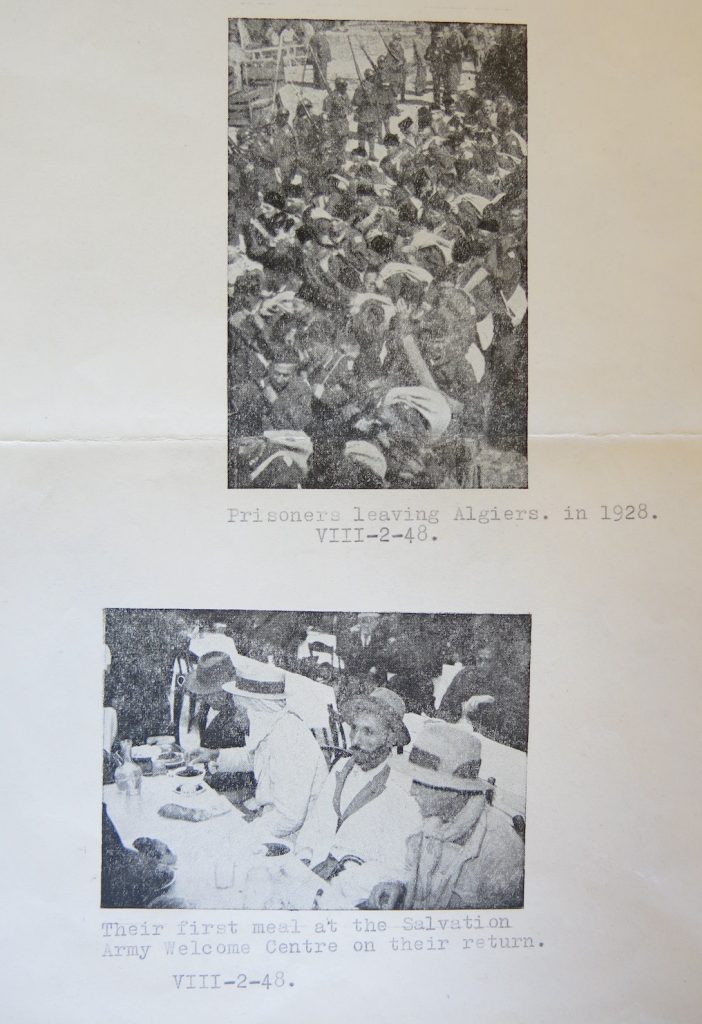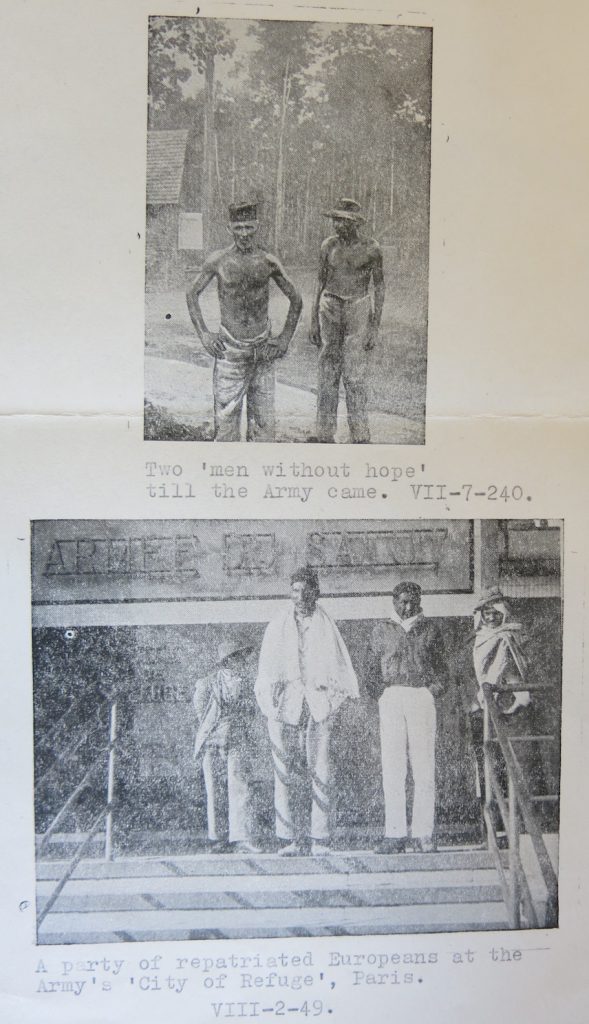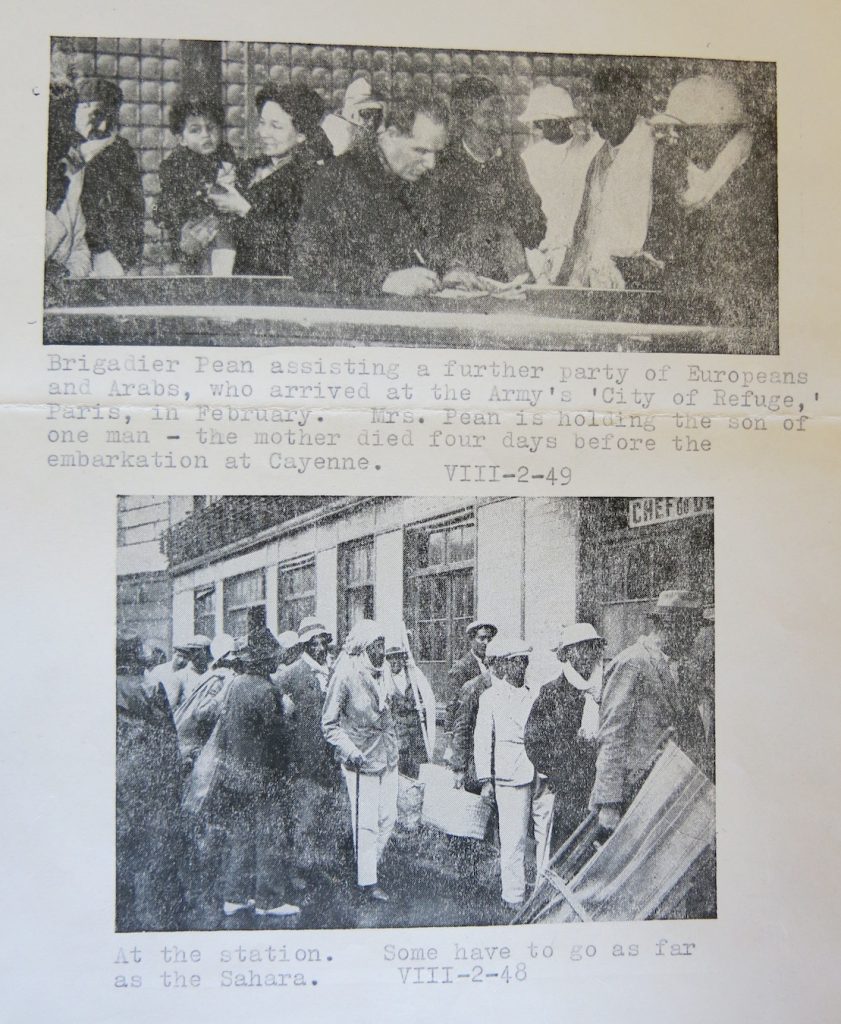Among the materials held in the archives of French Guiana is a box of papers relating to the activities of the Armée du Salut, or Salvation Army, in France’s mainland South American colony in the 1930s. French Guiana became a penal colony in 1854. It held under-sentence convicts from all over France and its empire, and ex-convicts who had served their term (known as libérés). Under the French law of doublage, convicts sentenced to more than 7 years were not allowed home until they had stayed in the colony for an equivalent number of years – for lifers that meant in perpetuity. With the labour market already saturated by convicts, many of them fell into destitution.
In 1929, a scandal broke in Europe after journalist Albert Londres returned to France and reported on the inhumanity of conditions in the penal colony. The Armée du Salut then received permission from the Ministry of the Colonies to despatch Adjutant Charles Péan to investigate. He did so, going out to the colony in July 1933 with the first contingent of Army officers. Their aim was to establish an infrastructure of support for the libérés. By this time the French had set up their own commission of enquiry, and they directed the Army to work closely with both the governor, Julien Lamy, and the director of the prison administration, Colonel Prével, in relief operations.
There were then just over 3,000 convicts in French Guiana, men who had been condemned to hard labour for life. They lived either in the capital at Cayenne, or in the Camp de la Transportation (Transportation Camp) in Saint-Laurent-du-Maroni on the river border with Dutch Surinam. There were also around 2,000 men who had been sent to the colony for repeat offences. They lived together in the Camp de la Rélégation (Recidivists’ Camp) in St Jean. Charles Péan later wrote that overall, around one third of the convicts and ex-convicts in the colony were North Africans, many of whom had been convicted of offences either in Paris or in French coal mines. Additionally, a handful of political prisoners lived offshore on the notorious Devil’s Island. Finally, there existed an unknown number of libérés (at least 1,500), the released prisoners who were compelled to stay. The Army became concerned mainly with the latter group, Péan noting that many of them lived with local women, with whom they had children. He also wrote about meeting Vietnamese libérés and a convict called Racoto, transported from Madagascar some 29 years earlier, as well as the local women who socialised generally with the convicts and ex-convicts.

One of Charles Péan’s accounts of the Salvation Army’s work in French Guiana
Building on earlier work among the homeless, by prison chaplain Father Adolphe Naegel who established a free dining hall (La Soupe Populaire) in Saint-Laurent-du-Maroni in the 1920s, after they arrived in the colony the Army was allocated an unused building, which it inaugurated as a foyer. It included dormitories, a meeting and recreation room, and a restaurant. This largely replaced the pre-existing Asile de Nuit (night shelter), though unlike the shelter libérés were obliged to pay a small charge to use the foyer‘s facilities. At the same time, the Army established a headquarters in Cayenne, and built a workshop for convicts to manufacture souvenirs. It had plans also to set up businesses for fruit canning and charcoal production, though ultimately the workshop was used to manufacture furniture for local use, supplemented by the Army’s sale of butterflies and insects gathered by convicts to overseas collectors.
A few kilometres outside Cayenne, under the charge of Lieutenant Klopfenstein, the Army also established a colonie agricole (agricultural colony, or farm) which it called Montjoly. The original intention was to grow vegetables that could be supplied to the Saint-Laurent-du-Maroni restaurant, but it developed to include also chicken coops, a piggery, and banana plantation – with fruit from the latter exported to France. Back in Saint-Laurent-du-Maroni, two Army officers joined the Committee of Patronage, which had been set up to assist the libérés, one of them as vice-president. They enjoyed considerable power, keeping a portion of the libérés’ wages until they left the colony (in the belief the men were not responsible enough to save money), and even being allowed to keep the savings of men who died.
The power of the Army in the colony was such that in 1935 the Commissioner of Police in Saint-Laurent-du-Maroni complained that people in the town regarded it as nothing less than a commercial operation. The Mayor agreed. ‘[I]t is,’ he wrote, ‘rather curious to find that the representative of an organisation that passes for philanthropic … systematically refuses to let a poor man sleep in its night shelter if he does not have 0.50 francs to pay.’ Colonel Prével, director of the prison administration, added that he had received numerous complaints about the Salvation Army. For example, libéré restaurant owners complained that the Army’s foyer had put them out of business. Libéré workers alleged that the director of operations in Saint-Laurent, Captain Chastaginer (or, Chastagné), had failed to deposit their wages in the bank on their behalf, as he was supposed to do; kept money that he was supposed to send to relatives overseas; and not shared funds or tickets sent from France to support their repatriation.
Traders in the town were not altogether happy about the presence of the Army either: some claimed that Chastaginer owed them money, and others that he had sold clothes sent from France that were meant for charitable distribution. The police officer in charge of the libérés, Gendarme Lavaud, added that the Army had told workers at Montjoly that it would pay for their repatriation after two years of service, docking wages in the meantime to cover the fare. However, not only did this contravene the law of doublage, but the Army also deliberately got rid of workers before this time was up, claiming that they were poor workers, had misbehaved, refused to convert, or were bad Christians. It then kept their accumulated wages. If anybody did convert, Lavaud added, they were made to write a letter to France, which was seen as a means of soliciting donations. The director of the prison administration Prével added further complaints. He claimed that Chastaginer sold garden produce from the foyer garden clandestinely at the market; and on several occasions had tried to access convict records, which was beyond his authority. Prével surmised: ‘the Salvation Army here is neither a charitable nor a humanitarian organisation. It is a commercial firm that looks to profit by all means, [and] shows no pity to the libérés.’
The Army, of course, had a somewhat different perspective. Pioneer Salvationist Charles Péan viewed operations in Saint-Laurent-du-Maroni as ‘flourishing’, explaining away any difficulties by noting ‘[o]ur operation in French Guiana is hampered by continual difficulties inherent in the category of men that we look to help.’ These difficulties apparently included a North African’s attempted to kill a Salvation Army lieutenant.
Governor Lamy attempted to intervene in these disputes, suggesting that the Army was profiting from the foyer, and withholding the pay of libéré workers dismissed from Montjoly. He also suggested that they encourage men to come to the foyer by serving of alcohol. Unsurprisingly for a member of a temperance organization, Charles Péan firmly rebutted this, responding that alcohol had caused ‘indescribable misery, ruin and eternal damnation,’ and that only total abstinence could guard against its dangers. He added that the Army made a loss from visitors to the foyer and that it was good practice not to pay men who were dismissed from the farm due to poor conduct. Péan added: ‘Without speaking of moral benefit (the most important) if these men allow our principles to penetrate them and open their hearts to God they have good and plentiful food, leisure, and books.’
Commissioner Albin Peyron, who travelled out to the colony in 1933, further reported the gratitude of the men he had encountered. One, he claimed, told him: ‘Your words are a balm poured upon our suffering.’ Another: ‘I thought I was alone in my sorry, but I find hands stretched out to help me – I hear a voice crying, “Courage! All is not lost! It is a miracle, an unhoped-for miracle; it is help from Heaven. From now on I am going to live another life, a life of hope”.’
Back in Paris, the Army began to work with the families of the convicts and libérés, supporting efforts for their return home. This came in the wider context of French discussions about the closure of the penal colony, in which the Army was engaged. The first repatriations came in 1936. About half of the men sent out of French Guiana went on to their homes in North Africa. The Second World War interrupted discussions about abolition, though the Army remained present in the colony. They greatly assisted the final repatriations, which took place during 1946 and 1947. A convoy first went to France, including two black women married to libérés. A handful of these former convicts ended up in the Army’s centre de relèvement et d’assistance par le travailat at Château de Radepont in Northern France, where they received assistance in the form of food and lodging. In a second phase of repatriation, the French shipped 1,500 North African libérés to Casablanca, Algiers, and Oran. The Salvation Army International Heritage Centre holds an extraordinary set of photographs of Algerian convicts, recording the men’s original departure and return.



Salvation Army International Heritage Centre CAR/4 French Guiana
The New York edition of the Army’s War Cry newspaper reported that when these colonial ex-convicts arrived ‘the men thronging the deck look with an emotion they do not hide, at their beloved country.’ Families gathered to await their arrival, sobbing, in what the newspaper described as a moving scene. Charles Péan claimed that the son of a former convict saw him in Algiers and rushed to kiss his hand: ‘he wanted to thank me for all I had done for his father’. This may have been an exaggeration, born out of a desire to stress the Army’s positive role. However, twinned with our knowledge of the local women who accompanied their French ex-convict husbands to Europe, it reminds us that when we research convict descent and family formation, we must be open to tracing global connections between sending locations, penal colonies, and sites of repatriation or emigration, as well as researching the children born to a convict parent. We will return to these issues in a subsequent blog.
Clare Anderson
Author’s note: An earlier version of this piece was published on the Salvation Army’s International Heritage Centre blog in September 2020. Take a look at this wonderful site here. I would like to thank the Army’s archivist Steven Spencer for both supporting my research on the Salvation Army and for allowing me to republish this blog here.
Sources:
- Charles Péan, Terre de Bagne (Paris: Renaissance Moderne, 1930).
- Archives Déparmentales de Guyane, Cayenne: Séries IX:
- Administration pénitentiaire: No. 79, Visite du pénitentiaire par l’Armée Salut, 1935.
- Salvation Army International Heritage Centre:
- CAR/4 French Guiana: War Cry, New York, 17 May & 25 October 1947; photographs (of Algerians and repatriation).
- MSW/7 Headquarters of the Men’s Social Work London: Report on the establishment of the work in French Guiana by Commissioner A. Peyron, Paris, 25 November 1933, enc. Interview with the press, November 1933.
- MSW/7 Salvation Army Men’s Social Services in Great Britain and Ireland: Report on the establishment of work in French Guiana (penal settlement), July 1935.
- S.61 Charles Péan, The Conquest of Devil’s Island (London: Max Parrish, n.d.)
- S.60 Charles Péan, Devil’s Island (London: Hodder and Stoughton, 1939).
- Jean-Claude Vimont, ‘Les récidivistes et l’Armée du Salut (1952-1970): L’assistance par le travail au château de Radepont (Eure), Criminocorpus [on line], 4 July 2012 (open access